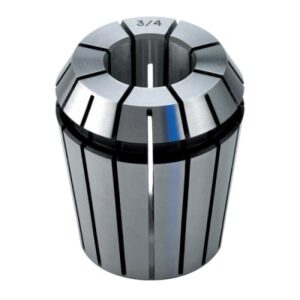
ER collets–Most machinists swear by them. The point is that the so-called er collet did not become a magic nail of the contemporary CNC operations overnight. The reason they were used as precision workroom backbones was that these little wonders became the most unique pieces in workrooms available to the precision worker. Let us flatten out our sleeves and have a glimpse of what makes them work.
First, flexibility. ER Collet is a make-do in the shop. An ER collet can accommodate different sizes with only one collet, unlike those jingling in old cabinets, never to be used again. It is tight on smaller tools and loosens up on bigger shanks. There is no constant tool swapping or any time wastage. You will see people smiling with huge smiles on their faces as they realize that they can swap a slightly larger end mill without having to start searching for another collet. It saves you money, and it relieves stress.
Now to grip. Nobody wants the expensive cutting tool to slip at some point during an operation. Sounds like a formula that leads to untameable lumps and some not-so-nice comments under the breath. The grip of the ER collet is fierce. It has a smart segmented print that covers the tool shank, distributing the pressure evenly. This chokehold keeps your bit clamped down, minimizing wiggle, slippage, and heart-sinking errors that plague the dreams of machinists.
Accuracy? Laser-sharp. The trick is in concentric clamping. The surface of the collets makes an equal pressure on all sides. This locks into your tool dead center every time. Tolerances remain tight, surfaces remain smooth, and repeatability is no longer a shot in the dark. This is why shops that require repeat results–batch after batch, shift after shift–sing their praises. A bit of shop floor conversation: Have you ever tried to do a hundred parts with a wobbly tool? Not to me, either–thanks to ER collets.”
Pragmatism should not be evaded. Longevity matters. Scenes in which and circumstances under which –collets laugh in the face of daily abuse. Angry chip dust, excessive splash, high-velocity chatter-these collets continue working hard with little or no complaint. Their shatter-proof steel makeup can withstand the heat, both literally and metaphorically, of the longest run of the day. The design is not fond of corrosion, but superior brands apply corrosion resistance treatments on their collets. Consider them your heavy work boots in the CNC toolbox: provided they are taken care of, they will last longer than the cheap ones.
What of undertime? The leanest margins operate the machine shops, and every minute that a spindle is at rest, money escapes. Interchangeability of tools with an ER collet is not painful. It slips in, you tighten the nut, and you are set to go. Reasonably hastened changes imply the additional chips off the floor and fewer lost minutes whilst managing the equipment. News of trying that with an outdated alternative and listening to what they groan.
Versatility colors another stripe on the badge of the ER collet. Milling, drilling, tapping–ER collets slide right along all those tasks with aplomb. No one-trick pony with this. You can always be certain of solid hold and precision, whether you are jewelry machining titanium or, well, tenderly pushing plastic into perfect form. This flexibility allows smaller stores to avoid the large outlays on specialty collectibles.
And there is ubiquity. Stranded abroad with a damaged collet? Probably, a duplication of an ER collet can be turned upon a single phone call. Practically all suppliers stock them, and there is none of the scarcity panic of those odd, proprietary systems. The resulting global standardization puts a burden on the planner.
However, do not neglect the small niceties that make ER collets different. There is a sweet spot for tightening. The problem with jaw-tightness does occur.T will be under-torque, and your tool may drift. They are overtightened and, well, you will hear the protest (and you will break something eventually). The ‘just right’ can do miracles, so there is a Goldilocks game played.
What does matter is a truth that is always circulating about CNC machines: If it ain’t broke, don’t fix it. The ER collet is not ideal- nothing is. When it comes to striking the right balance between accuracy, durability, speed, and availability, it strikes a near-perfect balance in most operations.
In short, as the technology of CNC takes giant leaps forward, the ER collet simply refuses to die. It is the backbone that gained its credentials. In the cut and thrust of the machine shop, this reliability is worth its weight in gold, or at least precision steel.
Despite new toolholding trends, machinists trust the ER collet for sheer practicality. Its mix of adaptability, strong grip, and widespread support means fewer headaches and smoother workflow on busy shop floors. As CNC needs shift, one thing stays solid—the ER collet keeps projects sharp, fast, and on target.
